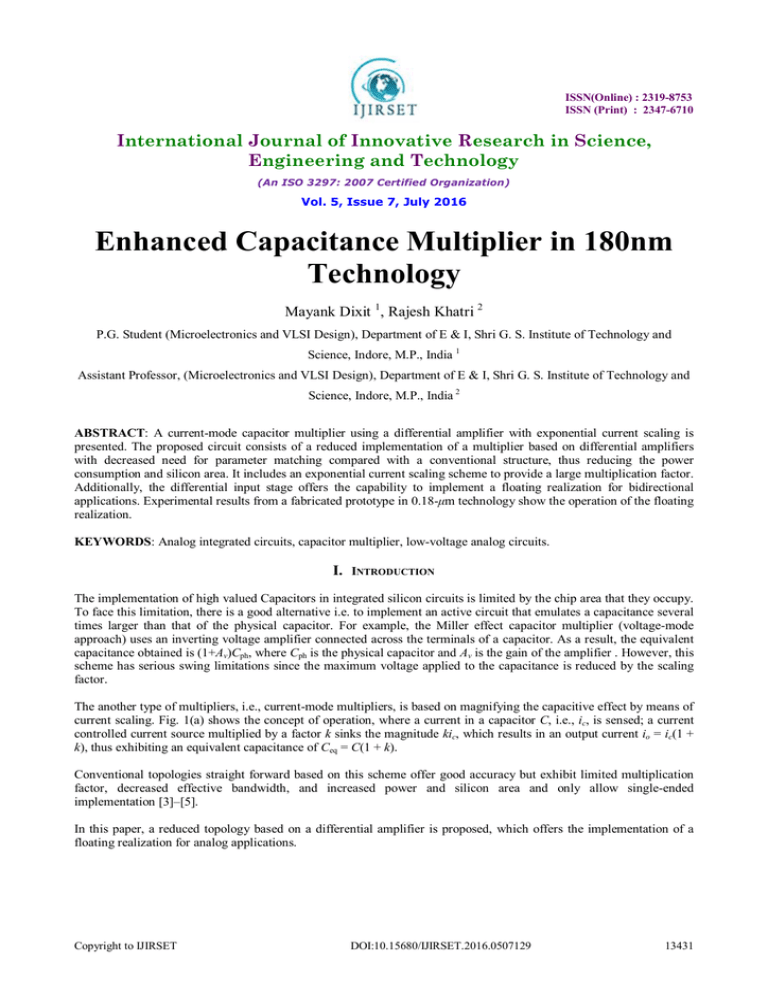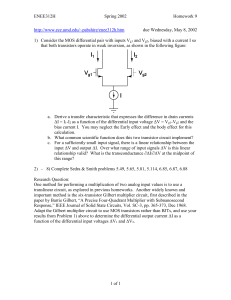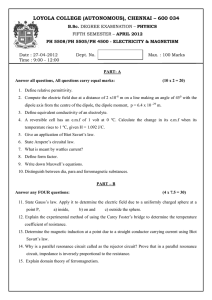Enhanced Capacitance Multiplier in 180nm Technology
advertisement

ISSN(Online) : 2319-8753 ISSN (Print) : 2347-6710 International Journal of Innovative Research in Science, Engineering and Technology (An ISO 3297: 2007 Certified Organization) Vol. 5, Issue 7, July 2016 Enhanced Capacitance Multiplier in 180nm Technology Mayank Dixit 1, Rajesh Khatri 2 P.G. Student (Microelectronics and VLSI Design), Department of E & I, Shri G. S. Institute of Technology and Science, Indore, M.P., India 1 Assistant Professor, (Microelectronics and VLSI Design), Department of E & I, Shri G. S. Institute of Technology and Science, Indore, M.P., India 2 ABSTRACT: A current-mode capacitor multiplier using a differential amplifier with exponential current scaling is presented. The proposed circuit consists of a reduced implementation of a multiplier based on differential amplifiers with decreased need for parameter matching compared with a conventional structure, thus reducing the power consumption and silicon area. It includes an exponential current scaling scheme to provide a large multiplication factor. Additionally, the differential input stage offers the capability to implement a floating realization for bidirectional applications. Experimental results from a fabricated prototype in 0.18-μm technology show the operation of the floating realization. KEYWORDS: Analog integrated circuits, capacitor multiplier, low-voltage analog circuits. I. INTRODUCTION The implementation of high valued Capacitors in integrated silicon circuits is limited by the chip area that they occupy. To face this limitation, there is a good alternative i.e. to implement an active circuit that emulates a capacitance several times larger than that of the physical capacitor. For example, the Miller effect capacitor multiplier (voltage-mode approach) uses an inverting voltage amplifier connected across the terminals of a capacitor. As a result, the equivalent capacitance obtained is (1+Av)Cph, where Cph is the physical capacitor and Av is the gain of the amplifier . However, this scheme has serious swing limitations since the maximum voltage applied to the capacitance is reduced by the scaling factor. The another type of multipliers, i.e., current-mode multipliers, is based on magnifying the capacitive effect by means of current scaling. Fig. 1(a) shows the concept of operation, where a current in a capacitor C, i.e., ic, is sensed; a current controlled current source multiplied by a factor k sinks the magnitude kic, which results in an output current io = ic(1 + k), thus exhibiting an equivalent capacitance of Ceq = C(1 + k). Conventional topologies straight forward based on this scheme offer good accuracy but exhibit limited multiplication factor, decreased effective bandwidth, and increased power and silicon area and only allow single-ended implementation [3]–[5]. In this paper, a reduced topology based on a differential amplifier is proposed, which offers the implementation of a floating realization for analog applications. Copyright to IJIRSET DOI:10.15680/IJIRSET.2016.0507129 13431 ISSN(Online) : 2319-8753 ISSN (Print) : 2347-6710 International Journal of Innovative Research in Science, Engineering and Technology (An ISO 3297: 2007 Certified Organization) Vol. 5, Issue 7, July 2016 Fig 1 Concept of operation of Current mode Capacitance Multiplier II. RELATED WORK The proposed circuit is shown in Fig. 2. It consists of a single differential pair formed by transistors M1–M6. Additionally, there is a multiplier section which multiplies the current value at the output of differential stage thus offering the factor k with the advantage of including a differential input stage. This increases the multiplication factor exponentially to k=1+k1k2k3 with reduced silicon area and power consumption. For the same scaling factor k and assuming equal gain factors of k1 = k2 = k3 = kx, the proposed circuit has an addition in power consumption and silicon area proportional to the factor 3(kx + 1). Fig. 2 Proposed Capacitance Multiplier Circuit Copyright to IJIRSET DOI:10.15680/IJIRSET.2016.0507129 13432 ISSN(Online) : 2319-8753 ISSN (Print) : 2347-6710 International Journal of Innovative Research in Science, Engineering and Technology (An ISO 3297: 2007 Certified Organization) Vol. 5, Issue 7, July 2016 The differential input stage offers an important advantage. It has the ability to define a voltage at both input terminals; if the non inverting input of the implementation is connected to ground, it operates as a grounded capacitor. However, this input can be utilized to sense other voltage variations; thus, an additional terminal may be defined in order to operate the circuit as a floating capacitor. The W/L ratio of transistors used in the proposed circuit is given below in Table 1. W/L Ratio(μm/μm) 1/0.18 1/0.18 1/0.18 1/0.18 1/0.18 1/0.18 3/1 1/0.18 9/3 3/1 27/9 9/3 Transistor Names M1 M2 M3 M4 M5 M6 M7 M8 M9 M10 M11 M12 III. EXPERIMENTAL RESULTS The open loop operation of the circuit is tested by giving inputs 0.85V DC, 1mV AC and 0.8V DC, -1mV AC at inverting and non inverting terminals respectively. The gain of Differential Amplifier is coming out to be ∼45dB. The output current value of Differential Stage is Io = 27.11μA and that of the Current Multiplier Stage is Iok = 760.02μA. These output current values are in agreement with the desired multiplication factor of current i.e. 27. The supply voltage of Vdd = 1.8 V and a biasing current of Ib = 30μA. The open loop frequency response of the Capacitance Multiplier Circuit is shown in figure 3. Fig. 3 Open loop frequency response of the proposed circuit Copyright to IJIRSET DOI:10.15680/IJIRSET.2016.0507129 13433 ISSN(Online) : 2319-8753 ISSN (Print) : 2347-6710 International Journal of Innovative Research in Science, Engineering and Technology (An ISO 3297: 2007 Certified Organization) Vol. 5, Issue 7, July 2016 The value of K is chosen to be 28 which means that each substage of current multiplier stage is multiplying the current value by 3. The output current value of current multiplier stage is Iok=760.02μA, which is k1*k2*k3 times the Io current i.e. 27 times the Io current. The circuit is tested for capacitance multiplication by implementing it in a RC low pass filter using floating configuration. The value of base capacitance taken is 80 pF, resulting in an equivalent capacitance Ceq = 2.24 nF (including a parasitic capacitance of ∼50 pF) combined with a resistor R = 22 kΩ. The measured cutoff frequency is ∼ 3.1 kHz for floating implementation. The reduced value of -3dB frequency to 1/28 times from the one which should be 94.98 KHz for R= 22K and C= 80pF proves that Capacitance Value is multiplied 28 times. The power consumption of the circuit is reduced to 0.612mW. The Layout diagram of the proposed circuit is shown in Fig. 6. The Table 1 is showing the comparison of the results obtained from the proposed circuit with the previous works done so far. Fig. 4 Capacitance Multiplier Circuit implemented in a RC Low Pass Filter with Floating Implementation. Copyright to IJIRSET DOI:10.15680/IJIRSET.2016.0507129 13434 ISSN(Online) : 2319-8753 ISSN (Print) : 2347-6710 International Journal of Innovative Research in Science, Engineering and Technology (An ISO 3297: 2007 Certified Organization) Vol. 5, Issue 7, July 2016 Fig. 5 Frequency Response of RC Low Pass Filter implemented by Capacitance Multiplier Circuit. Fig. 6 Frequency Response of RC LPF showing Power Consumption in the Circuit. Copyright to IJIRSET DOI:10.15680/IJIRSET.2016.0507129 13435 ISSN(Online) : 2319-8753 ISSN (Print) : 2347-6710 International Journal of Innovative Research in Science, Engineering and Technology (An ISO 3297: 2007 Certified Organization) Vol. 5, Issue 7, July 2016 . Fig. 7 Layout Diagram of proposed Capacitance Multiplier Circuit Parameter [3] [4] [5] Technology (µm) 0.35 0.18 0.5 0.5 0.18 Multiplication factor 16 65 10.1 28 28 Base capacitance C (pF) 170 7.95 18 25 80 Ceq (pF) 2720 716 182 700 2240 Power Consumption (mW) 0.672 _ _ 1.32 0.612 Min. Supply volt. (V) _ _ _ 1.3 1.8 Silicon area (mm2) _ _ 0.07 0.00056 0.0702 [9] (Base Paper Work) Results Obtained Table 2 Comparison of measured parameters between Conventional Circuits and Proposed Circuit. Copyright to IJIRSET DOI:10.15680/IJIRSET.2016.0507129 13436 ISSN(Online) : 2319-8753 ISSN (Print) : 2347-6710 International Journal of Innovative Research in Science, Engineering and Technology (An ISO 3297: 2007 Certified Organization) Vol. 5, Issue 7, July 2016 IV. CONCLUSION A capacitor multiplier based on a differential amplifier with exponential current scaling has been presented. The single differential input stage offering increased accuracy and reduced silicon area and power consumption was discussed. The differential input stage also offers the capability to implement grounded and floating realizations. Experimental results showing the operation of the floating circuit implemented in low-pass RC filter is presented. REFERENCES [1] G. A. Rincon-Mora, “Active capacitor multiplier in Miller-compensated circuits,” IEEE J. Solid-State Circ., vol. 35, no. 1, pp. 26–32, Jan. 2000. [2] G. Giustolisi, G. Palumbo, and E. Spitale, “Robust miller compensation with current amplifiers applied to LDO voltage regulators,” IEEE Trans. Circuits Syst. I, Reg. Papers, vol. 59, no. 9, pp. 1880–1893, Sep. 2012. [3] H. B. Le, X. D. Do, S. G. Lee, and S. T. Ryu, “A long reset-time power on reset circuit with brown-out detection capability,” IEEE Trans. Circuits Syst. II, Exp. Briefs, vol. 58, no. 11, pp. 778–782, Nov. 2011. [4] I. C. Hwang, “Area-efficient and self-biased capacitor multiplier for on-chip loop filter,” Electron. Lett., vol. 42, no. 24, pp. 1392–1393, Nov. 2006. [5] S. Solis-Bustos et al., “A 60-dB dynamic-range CMOS sixth-order 2.4-Hz low-pass filter for medical applications,” IEEE Trans. Circuits Syst. II, Analog Dig. Signal Process., vol. 47, no. 12, pp. 1391–1398, Dec. 2000. [6] J. Choi, J. Park,W. Kim, K. Lim, and J. Laskar, “High multiplication factor capacitor multiplier for an on-chip PLL loop filter,” Electron. Lett., vol. 4, no. 5, pp. 239–240, Feb. 2009. [7] J. Aguado-Ruiz et al., “Programmable capacitance scaling scheme based on operational transconductance amplifiers,” Electron. Lett., vol. 45, no. 3, pp. 159–161, Jan. 2009. [8] J. Aguado-Ruiz et al., “Three novel improved CMOS C-multipliers,” Int. J. Circuit Theory Appl., vol. 40, no. 6, pp. 607–616, Jun. 2012. [9] Ivan Padilla-Cantoya and Paul M. Furth,” Enhanced Grounded Capacitor Multiplier and Its Floating Implementation for Analog Filters,” IEEE Trans. Circuits Syst. II: Express Briefs, Vol. 62, No. 10, October 2015. Copyright to IJIRSET DOI:10.15680/IJIRSET.2016.0507129 13437





